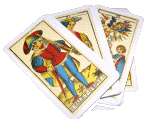
Bohemian Gothic Tarot
TEN OF CUPS
Lighter or more conventional meanings
Feeling thankful and happy about the simple pleasures in life * "Count your blessings" * Enjoying your family and domestic life * Humble, homely achievements bring satisfaction.
Darker, shadow or more hidden meanings
A dysfunctional family * A claustrophobic, oppressive aspect to your domestic life * A child (or "inner child") that is not being well cared for, this could be physical or psychological.
As the ultimate expression of the suit, the Ten of Cups is usually portrayed as the "Happy Family" card. It's about the joys that come from close family and friends and from your domestic and home life. In the traditional RWS card it shows a great sense of fulfilment and success, though this is not of the high status, fame and riches type that's so often admired.
Our card shows a family in which the general air of dysfunctionaliry and tension runs high. The mother, though beautiful, looks stern and anxious as she stares at the father. He glares angrily out at the viewer, as though daring us to challenge his status and his manner of running his household. He looks somewhat mad, as though about to burst into a ranting series of insane accusations. Meanwhile an unutterably sad little girl stands apart with her toy horse, lost in her own thoughts. The whole scene is a vivid expression of the sheer hostility and tragedy that can be locked up in a family that doesn't show the normal sense of care and kindness to its members. The father here gives the impression of a man on the verge of irrational, crazed fury, and the mother seems hysterical, perhaps with good reason. They are obviously prosperous in terms of money; their home looks impressively large and lavish and they are well-dressed. But their wealth has obviously brought no happiness.
In contrast to the airy, lively image on the traditional RWS card, this scene seems claustrophobic, dark and oppressive. Where the RWS family dance outside in the sunlight and celebrate the appearance of a rainbow in the sky, our Bohemian Gothic family sits inside a dark hall lit with lanterns. The vaults of a Gothic ceiling take the place of the arc of the rainbow, and no-one seems in the least celebratory. In a reading, this card asks us to question the way a family group is working and what are the positive and negative influences on everyone within. It may ask us to look at our current family set-up, or to think back to our childhood. If we can see clearly both the good and the bad we might be in a better position to make sure that our own family functions well.
Some further ways to consider this card
The man on this card looks quite strikingly similar to the figure on the Nine of Cups. Is it possible that they are one and the same person? If so, in the Nine he is quite a young man, and in the Ten he is shown grown older and with a family. If these cards fall together in a reading, would you link them in this way and how could this affect your reading of them?
MADNESS AND DELUSION
At the heart of Gothic fiction is the theme of slowly-building terror, sometimes caused by a psychological rather than a physical threat. Often the source of this fear is mysterious and unknown, emanating from the supernatural or demonic. But throughout the genre there is a frequent implication that the fear might be caused by madness rather than by any actual happenings - many pieces of classic Gothic fiction play on an uncertainty about the protagonist's sanity. Lunacy and mental derangement play a central feature in such tales. There may be the suggestion of demonic or spirit possession as the root cause of psychosis, or depression and ennui might be depicted as the result of hauntings or other night terrors. In Onions' truly terrifying The Beckoning Fair One, we witness the central character's slow descent into madness caused by a murderously jealous phantom. Her pervasive influence makes his world increasingly confined, deluded and paranoid until he becomes unable even to rise from his bed:
He was suddenly wondering whether he dared go into the kitchen. It was such a frightfully long way; no man knew what horror might not leap and huddle on his shoulders if he went so far; when a man has an overmastering impulse to get back into bed he ought to take heed of the warning and obey it. Besides, why should he go? What was there to go for? If it was that Bengough creature again, let her look after herself; Oleron was not going to have things cramp themselves on his defenceless back for the sake of such a spoilsport as she!... If she was in, let her It herself out again, and the sooner the better for her! Oleron simply couldn't be bothered. He had his work to do. On the morrow, he must set about the writing of a novel with a heroine so winsome, capricious, adorable, jealous, wicked, beautiful, inflaming, and altogether evil, that men should stand amazed. She was coming over him now; he knew by the alteration of the very air of the room when she was near him; and that soft thrill of bliss that had begun to stir in him never came unless she was beckoning, beckoning....
- Oliver Onions, The Beckoning Fair One.
In Oscar Wilde's The Picture of Dorian Gray, the madness of the central character becomes increasingly noticeable over some years, the result of a "mad wish" to remain beautiful for ever which, by implication, has been granted by demonic powers. Towards the end of the novel Dorian is still lovely to look at but absolutely crazed by his bizarre situation and the dark deeds into which he has been drawn as a consequence:
He felt that if he brooded on what he had gone through he would sicken or grow mad. There were sins whose fascination was more in the memory than in the doing of them, strange triumphs that gratified the pride more than the passions, and gave to the intellect a quickened sense of joy, greater than any joy they brought, or could ever bring, to the senses. But this was not one of them. It was a thing to be driven out of the mind, to be drugged with poppies, to be strangled lest it might strangle one itself.
- Oscar Wilde, The Picture of Dorian Gray.
Edgar Allan Poe was master of the use of madness as a theme and many of his most famous characters are clearly disturbed if not outright insane. Interestingly, he tends to attribute this, in his stories, to genetics, the inescapable result of being born into a family prone to madness. Here are his descriptions of first Roderick Usher and then William Wilson:
His countenance was, as usual, cadaverously wan - but, moreover, there was a species of mad hilarity in his eyes - an evidently restrained hysteria in his whole demeanour. His air appalled me.
- Edgar Allan Poe, "The Fall of the House of Usher", Tales of Mystery and Imagination.
I am the descendant of a race whose imaginative and easily excitable temperament has at all times rendered them remarkable; and, in my earliest infancy, I gave evidence of having fully inherited the family character. As I advanced in years it was more strongly developed; becoming, for many reasons, a cause of serious disquietude to my friends, and of positive injury to myself. I grew self-willed, addicted to the wildest caprices, and a prey to the most ungovernable passions. Weak-minded, and beset with constitutional infirmities akin to my own, my parents could do but little to check the evil propensities which distinguished me.
- Edgar Allan Poe, "William Wilson", Tales of Mystery and Imagination.
Going one step further, some of the most effective and disturbing stories keep the reader unsure as to the sanity of not just the characters, but the narrator. Henry James' The Turn of the Screw is probably the most famous example; nothing in the tale confirms the reality of the events which, it's implied, could be all in the mind of the neurotic nanny who has written it. Towards the end of the story, as she questions Miles, one of the children in her charge, she herself has a moment of doubt about her own perceptions:
I seemed to float not into clearness, but into a darker obscure, and within a minute there had come to me out of my very pity the appalling alarm of his being perhaps innocent. It was for the instant confounding and bottomless, for if he were innocent, what then on earth was I? Paralysed, while it lasted, by the mere brush of the question, I let him go a little, so that, with a deep-drawn sigh, he turned away from me again; which, as he faced toward the clear window, I suffered, feeling that I had nothing now there to keep him from.
- Henry James, The Turn of the Screw.
In modern times, the depiction of insanity is common in Gothic literature and films. It's shown either as the root cause of paranoid imaginings or, alternatively as the result of the evil attentions of ghosts and spirits. Jack Torrance, the crazed writer locked up for the winter in the haunted Overlook Hotel is the most famous example; he's become so iconic that some of his utterances have passed into popular culture. It's never entirely clear in either the film or the Stephen King novel on which it's based, whether Jack is genuinely meeting phantoms or whether it's all in his mind, as he gradually loses his sanity and slips into delusion. John Carpenter's In the Mouth of Madness makes insanity and the loss of reality into the central action of the film, which is a tribute to HT Lovecraft's 1930 novella, At the Mountains of Madness. While Lovecraft is not quite a classic Gothic writer it would be almost impossible not to mention him in a discussion of madness in the horror genre. More than any other writer, he created an entire mythos of a world that was permanently on the verge of lunacy - horror indeed.









